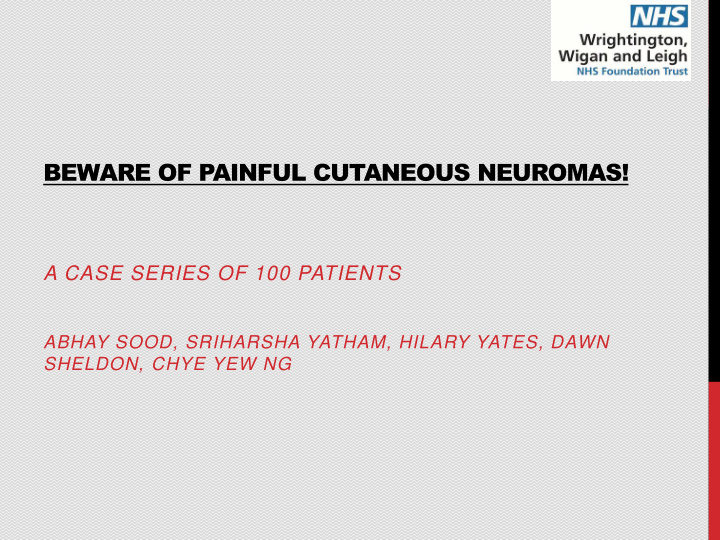



BEWARE OF PAINFUL CUTANEOUS NEUROMAS! A CASE SERIES OF 100 PATIENTS ABHAY SOOD, SRIHARSHA YATHAM, HILARY YATES, DAWN SHELDON, CHYE YEW NG
OBJECTIVE • To study the causation and outcome of painful cutaneous neuromas (PCN). METHODS • Retrospective review of 100 consecutive patients with PCN • Diagnosis was clinical confirmed with local anaesthetic blockade • Every patient was offered pharmacotherapy, physiotherapy and transcutaneous neuromodulation • Neuroma surgery as the last resort
RESULTS Location of neuromas • Between 2014 - 2019 • 59 females and 41 males Foot & ankle, • Mean age 49 years 15 (range 16-81) Hip & knee, 6 Shoulder & elbow, 12 Hand & wrist, 79% due to iatrogenic injury 67 21% due to direct trauma
Region Nerve Number Hand & wrist Superficial radial nerve 29 Dorsal cutaneous branch of ulnar nerve 9 Palmar cutaneous branch of median nerve 19 Digital nerve 10 Shoulder & elbow Medial antebrachial cutaneous nerve 6 Lateral antebrachial cutaneous nerve 2 Supraclavicular nerve 3 Dorsal cutaneous (medial scapula) 1 Hip & knee Lateral femoral cutaneous nerve 2 Saphenous nerve 2 Infrapatellar nerve 2 Foot & Ankle Saphenous nerve 4 Superficial peroneal nerve 6 Sural nerve 4 Medial Plantar Nerve 1
OUTCOME Improved Not Improved Lost to Follow up 28 27 22 11 9 3 Non-Operative Operative
CONCLUSION • The vast majority of PCN in both upper and lower limbs are due to iatrogenic injury. • This is potentially avoidable with better appreciation of neural anatomy and soft tissue handling. • Approximately half would respond to therapy targeted at the neuroma.
Recommend
More recommend